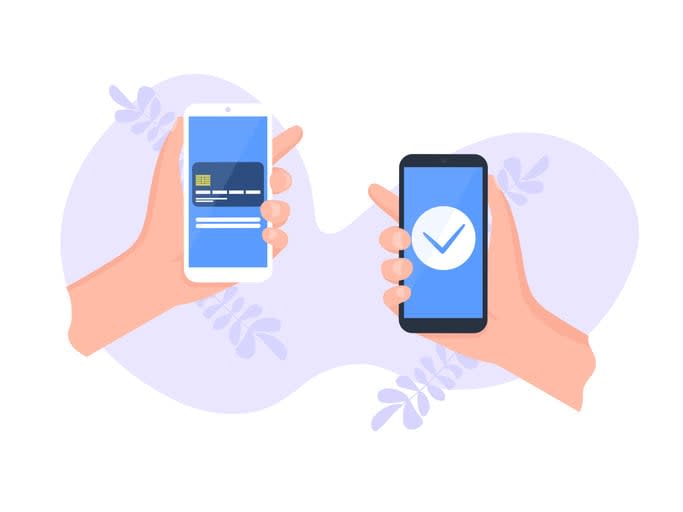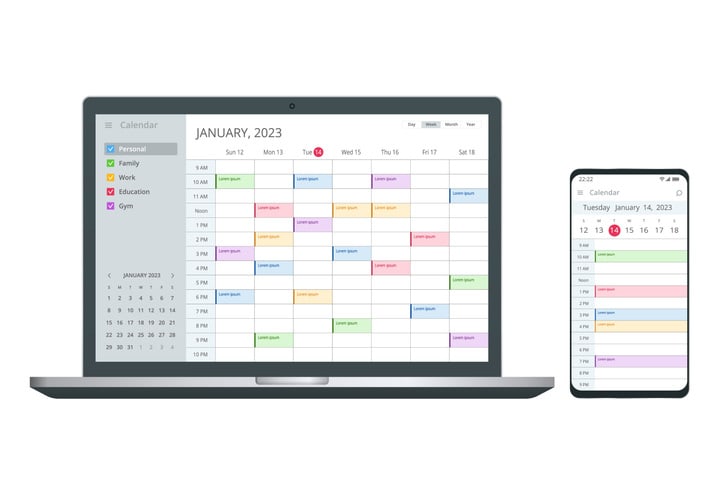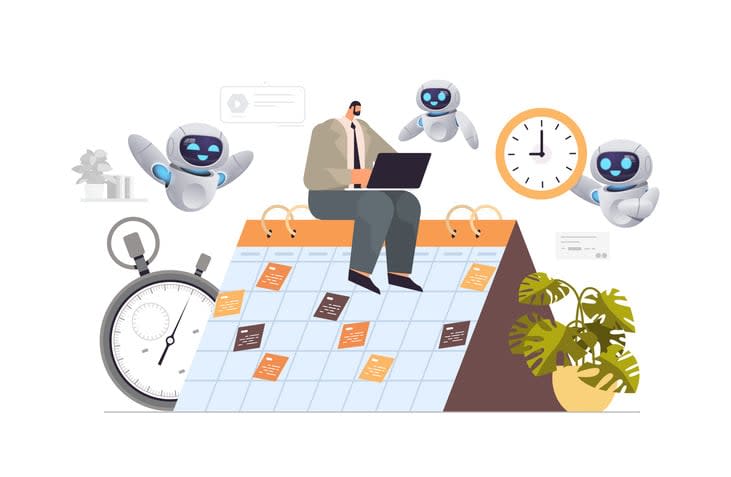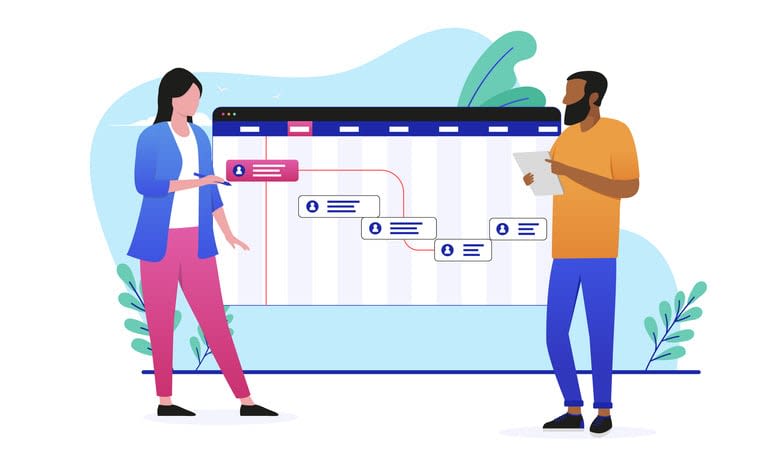Searching for a way to optimize your time management? Look no further. In this deep dive, we’ll explore the top software schedule solutions that can radically improve your productivity in 2024. Discover key features, integration tips, and how the right tool can align with your business needs. Prepare to streamline your scheduling process and reclaim valuable time.
Key takeaways
- Modern software, like Kumospace and Zoho Bookings, combines traditional calendaring with advanced features such as AI, virtual spaces, and data analytics to boost time management and productivity.
- Integration with existing business tools, smart resource management, and intuitive UI are critical elements that contribute to the effectiveness of scheduling solutions.
- Scheduling software isn’t just for large companies; it also offers significant benefits to service professionals and sales teams with specialized tools and capabilities to streamline their unique workflows.
The evolution of scheduling software

The journey of scheduling software began in the 1950s with the development of rudimentary techniques such as ADM, which provided a formalized structure for scheduling meetings. This was closely followed by methodologies like PERT and CPM that further enhanced the scheduling process. As computer technology advanced, so did scheduling software. It evolved from bulky mainframe systems to the easily accessible personal computers we have today, making scheduling tools available to a larger audience.
Today, scheduling systems have come full circle, returning to centralized enterprise systems. This shift is facilitated by Project Management Offices (PMOs) that offer networking and web-enabled capabilities. The journey from the rudimentary ADM to today’s sophisticated software is a testament to the relentless pursuit of efficiency in managing time and scheduling meetings.
The importance of scheduling software in today's business landscape

Scheduling software provides numerous business benefits, including:
- Minimizing the need for multitasking, enabling managers to focus on critical task and boosting productivity
- Effective time management, leading to better productivity and goal achievement
- Essential tools for achieving business objectives
The impact of scheduling software extends beyond mere productivity. It aids in:
- Streamlining project management efforts
- Facilitating efficient workflow practices
- Offering clients the convenience of booking meetings anytime
- Improving customer engagement
- Driving business actions
Clearly, scheduling software plays a pivotal role in the modern business landscape, and utilizing a scheduling app can further streamline the process.
Integrating virtual spaces with scheduling tools: the Kumospace advantage
Enter Kumospace, a virtual space that integrates with Google Calendar, enabling users to view and manage calendar events within the virtual space itself. This integration streamlines the meeting scheduling process, making it easier for users to manage their time efficiently.
However, Kumospace isn’t solely a scheduling tool. Its spatial audio technology simulates real-life interactions by allowing conversations to fade as users move around the virtual space. This fosters a more natural and engaging online meeting experience.
Add to that interactive features like ‘knocking on doors’ for private conversations and virtual coffee bars for networking, and you have a platform that not only simplifies scheduling meeting requests but also enhances the entire virtual meetings experience.
Essential features of top scheduling software

Considering the features of a scheduling tool is an important step when making a selection. The integration of AI in scheduling tools, for instance, promises to significantly reduce the time spent on manual scheduling, potentially reclaiming a significant portion of the workday for productive tasks. AI scheduling assistants can:
- Manage recurring events
- Reschedule conflicts automatically
- Prioritize tasks, improving time management
- Enable automated follow-up with leads
- Manage large volumes of meeting invitations efficiently using natural language understanding
- Automate and optimize availability management when professionals clear events from their calendars to create more availability
We’ll now examine some key features of top-tier scheduling software, including Seamless Calendar Integration, Smart Resource Management, and Intuitive User Interface.
Seamless calendar integration
Scheduling software is revolutionized by seamless calendar integration. It offers the following benefits:
- Eliminates the need for back-and-forth emails
- Automates reminders
- Streamlines appointments
- Prevents situations like double bookings
Some tools for calendar management include:
- Calendar, which serves as a comprehensive calendar app offering meeting statistics
- Cal.com, which offers a high level of flexibility with customization options on the back-end
- Zoho Bookings, which integrates two-way calendar synchronization with Zoho, Google, and O365/Outlook.com calendars, making schedule management across platforms seamless.
Smart resource management
Any scheduling tool must have effective resource management. Collaborative calendar systems allow team members to input their individual availability, improving collaboration and resource transparency.
Effective resource planning starts with a Work Breakdown Structure, which prioritizes tasks and monitors project progress to manage resources without overburdening team members. Appointment scheduling software offers insights into appointment distribution, enhancing resource allocation and potentially reducing staffing costs.
Intuitive user interface
Another key aspect of any scheduling tool is the user interface. Intuitive scheduling software interfaces prioritize simplicity, avoiding unnecessary distractions to facilitate quick navigation and goal achievement.
Adopting familiar design patterns in scheduling software interfaces simplifies the learning process for users, allowing them to operate the software with minimal instruction. Consistent user interface elements make interaction more predictable and create a sense of familiarity, thus improving usability.
Maximizing efficiency with automated scheduling solutions

Automation capabilities often determine a scheduling tool’s efficiency. Automated scheduling features such as reminders and follow-ups play a crucial role in ensuring higher attendance rates and timely starts for appointments. By allowing users to easily schedule appointments, these tools significantly save time and reduce no-shows.
Automated reminders and follow-ups before scheduled meetings prompt attendees, enhancing punctuality and reducing the frequency of missed meetings. Recurring meeting setups ensure continuous tracking of project progress and accountability, with the convenience of sending a single invite that reminds all team members of the meeting.
Payment and booking page customization

Any scheduling tool must have customization capabilities. SimplyBook.me, for instance, facilitates payment transactions during the booking process or on-site through integrations with various processors such as Stripe, PayPal, and other systems.
Customization also extends to the booking experience, enabling businesses to align their online presence with in-house branding. Zoho Bookings’ Premium plan, for example, allows businesses to port booking pages to their domain and remove default platform branding.
Strategies for effective team coordination using scheduling apps

Team coordination can also be improved by leveraging scheduling apps. Tools like Zoho Bookings support multiple staff and locations, enabling teams to manage and harmonize schedules effectively across various branches or remote teams.
Holding regular group meetings through scheduling software:
- Maintains transparency
- Improves communication
- Reduces misunderstandings among team members
- Fosters a collaborative and understanding team environment.
Choosing the right scheduling software for your needs

Selecting the appropriate meeting scheduling software might seem challenging. But don’t worry, we’ve got you covered. A good meeting scheduler is essential for efficiently setting the time and location for meetings and appointments. It is a useful tool for managing your schedule and ensuring that everyone is on the same page. Consider using a free meeting scheduler to schedule meetings effectively, as it must be secure, with a clear privacy policy for data usage, safeguarding the privacy and security of user data.
Automated meeting schedulers save time, reduce the likelihood of errors, and enable scheduling sales meetings even after business hours, providing a better experience to prospects and clients. When selecting a scheduling tool, considerations include matching individual wants and needs and ensuring vendor expertise and support for ongoing adaptation and growth with the business.
The future of scheduling: AI and data analytics

Looking ahead, it’s evident that AI and data analytics will significantly influence scheduling. AI-powered scheduling tools leverage real-time data to suggest optimal meeting times based on participant availability and preferences, as well as dynamically optimizing resource allocation.
Services like Clara provide AI scheduling assistance without the need for regular platform interaction, streamlining the meeting coordination process. Advanced scheduling tools offer analytics dashboards with insights on meeting patterns, durations, and efficiency, as well as detailed counts of schedule assists and conflict resolution.
Streamlining your entire business with Zoho Bookings

Another tool causing a stir in the scheduling software arena is Zoho Bookings. It enables businesses to manage their entire booking workflow, including:
- appointment scheduling
- rescheduling
- reminders
- follow-ups
Zoho Bookings integrates with a variety of business tools, including:
- Zoho CRM
- Zoho Invoice
- Zoho Mail
- Zoho Analytics
This facilitates a streamlined process. Plus, it offers transparent pricing options, ranging from a free plan for individual users to paid plans starting at $6/user/month, with the Premium plan available as part of Zoho One suite.
Navigating the scheduling process with advanced tools

As demonstrated, advanced tools like appointment scheduling apps have made navigating the appointment scheduling process more effortless than ever. Rallly’s user-friendly interface simplifies the creation, sharing, and management of appointment polls, contributing to an efficient scheduling process.
Advanced scheduling tools, including meeting scheduling tool platforms such as SavvyCal, enable participants to easily identify mutually available times, send invites, and synchronize meetings with their calendars. These tools offer a combination of polling with standard scheduling features, permitting invitees to overlay their own calendars on the polling page for better coordination.
Simplified scheduling for service professionals

Not only large companies benefit from software scheduling. Individual service professionals can also benefit from simplified scheduling. Some tools that cater to these professionals include:
- Fantastical, which offers free basic calendars and premium plans starting at $5/month
- Apple Calendar, which provides scheduling options for Apple users
- Microsoft Outlook Calendar, which offers premium plans starting at $7/month for Microsoft 365 Personal
These tools can help service professionals manage their schedules more efficiently.
Specialized tools such as Acuity Scheduling, SimplyBook.me, and Book Like A Boss offer features tailored for service businesses with plans starting at $16/month for Acuity Scheduling and free plans for up to 50 bookings per month with SimplyBook.me.
Meeting schedulers and project management software synergy

Workflows and efficiency can be improved through the integration of meeting schedulers and project management software. Integrated meeting schedulers in project management tools can automate scheduling in the context of project timelines and deliverables.
Project management software allows for:
- Detailed visualization of resources, milestones, and tasks
- Improved efficient tracking, coordination, and execution of tasks
- Advanced project management tools, like Motion, use AI to dynamically adjust schedules taking into account priorities and deadlines, facilitating proactivity and adaptability.
The impact of scheduling software on sales teams

Scheduling software can be particularly beneficial to sales teams. Sales reps spend a significant portion of their time setting up meetings, which can be streamlined with scheduling software to enhance productivity. Advanced scheduling systems aid in increasing productivity and saving time through effective resource management.
Calendly simplifies the process of scheduling incoming meetings with just a few clicks, directly assisting in sales activities. SalesBlink, for instance, includes a built-in meeting scheduler designed for the unique needs of salespeople.
Kumospace's role in enhancing online meeting schedulers
Returning to Kumospace, this platform introduces a new dimension to online meeting schedulers. Kumospace offers an alternative to traditional video conferencing by providing interactive virtual spaces where users can network and engage as if they were together in person.
The platform allows for significant customization, letting users personalize virtual spaces with company branding, furniture, music, and YouTube videos to suit various types of events. Furthermore, Kumospace includes comprehensive tools for screen sharing and broadcasting, which are essential for presentations and announcements to large audiences in a virtual setting.
Summary
In conclusion, the evolution of scheduling software has revolutionized the way we manage time, coordinate teams, and conduct business. Whether it’s AI-powered tools, calendar integrations, or immersive virtual spaces like Kumospace, these solutions are making scheduling meetings easier and more efficient than ever. As we look to the future, the potential advancements in AI and data analytics promise to further enhance the scheduling process. After all, time is our most valuable resource, and scheduling software helps us make the most of it.
Frequently Asked Questions
The most commonly used scheduling system is time-slot scheduling, also known as stream scheduling. It allows customers to choose from a list of available time slots.
You can use Chili Piper or YouCanBook.me for scheduling meetings specifically for your sales team, or consider Google Calendar and Hubspot Meeting tools for budget-friendly options.
Top scheduling software should have AI capabilities, seamless calendar integration, smart resource management, and an intuitive user interface to make scheduling tasks efficient and easy to manage.
Automated scheduling improves efficiency by sending reminders and follow-ups, leading to higher attendance rates and timely appointments, ultimately saving time and reducing no-shows. It's a game-changer for productivity!
When choosing scheduling software, it's important to consider how well it matches your specific needs and the support provided for ongoing adaptation and growth with your business. Keep these factors in mind to make the right choice.





